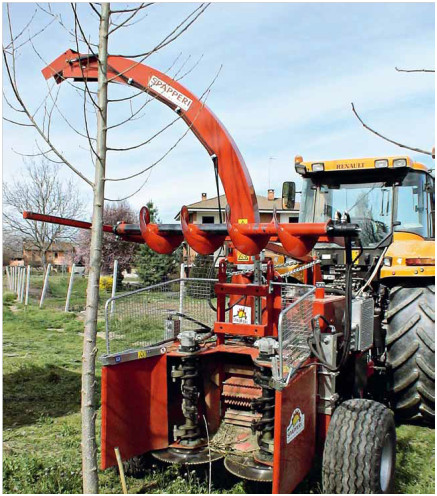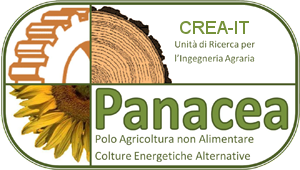The actually demands of the industry and panel industry are oriented towards the acquisition of a poplar chip product characterized from a low percentage of cortex, consequently it is better to harvest the cultivation when it has 2 or more years. In the photo n.1 the products are putting to comparison obtained from the cutting of the same variety of poplar of 1 and 2 years of age of the stump: the different can be appreciated visually also amount of cortex.
Moreover the harvesting machineries remarkably affect the economic income of the cultivation often representing factor determined in the entrepreneurial choice.
To the aim to activate the development of SRF harvesting machines, ENAMA (National Farm Mechanization Body) has promoted, in the program for the agricultural machineries technological the construction of one suitable operating machine to SRF harvesting with advanced operative dimensions to the limits over reported. A prototype has been constructed from the Spapperi Company Mechanical Constructions S.r.l. with scientific collaboration of the CRA, Experimental Institute for Agricultural Mechanization. The prototype is currently subordinate to a program of tests ,whether experimental tests, finalized to verify the correct formulation planned and the main operative parameters, or running tests, in various operating conditions of harvesting for entire winter season 04/05 by the work of Agriforest sea’s., Company specialized in the row agriculture-wood-energy, on poplar of 2 and 3 years of age in order to verify characteristics of resistance and usury of the several apparatus and also the general reliability of the same machine.
In this mark, it is reported the main operative results from the first experimental tests conduced on the prototype and also the calculation of the harvesting costs.
 The machine is of type half-carried, it is connected to the posterior tractor raiser and receives the motion from the pto of an endowed tractor of reversible guide (in the course of the tests it has been used a Lamborghini 190 of 140 kW of the maximum power) and in phase of work rests on two wheels that support in part the weight, and unwind, also, function of regulation of the height of cut.
The machine is of type half-carried, it is connected to the posterior tractor raiser and receives the motion from the pto of an endowed tractor of reversible guide (in the course of the tests it has been used a Lamborghini 190 of 140 kW of the maximum power) and in phase of work rests on two wheels that support in part the weight, and unwind, also, function of regulation of the height of cut.
The operating machine unloads the cut product on a wagon hauled from the same tractor or on wagon pulled ahead from other tractor that is left over in parallel with the operating machine.
The machine is composed from one apparatus of cutting by disk mounting two radial knives to which is combined a harvesting heading fortified of two circular blades, a pushing system at Y in order to favourite the entrance of the plants and a couple of rolls opposite-rotating for the feeding of the cutting apparatus.
The cutting apparatus is constituted from two circular opposite-rotating blades from 550 mm of diameter with a report in widia of 6 mm of thickness, realized specifically in order to operate until 2500 turns/min.
The blades set in action from a hydraulic pump with a volume of 51, 4 cc/turn (80 l/min) has a speed rotation equal to 2200 turns/min.
The cut apparatus has been interested from various modifications during the development of the prototype. A first modification has regarded the approach of the cutting margins of two discs and the consequent elimination of the wedge element put between the same blades.
Also the carter over the blades of cut has endured some modifications. At first the made blade covered the entire blade, exception for the field used after the cut bases of the plant. Subsequently, to continuation of the strong resistances between blade and Carter provoked from the entrance of product between the two organs Carter has been reshaped leaving uncovered all the field of the blade on which the plant slides before being seized from the conveyor rolls.
The feeding apparatus is constituted from two opposite-turning vertical rolls, provided with a set of teeth, moved by hydraulic motors and places over the blades’ cut, in axis, to direct the plants toward the two horizontal feeder rolls.
These last ones are toothed and opposite-turning, rotate on horizontal axle: the superior one is moved by an hydraulic motor of 400 cc/turn, has a diameter of 270 mm and length of 350 mm, is provided with a set of teeth and is risible in relation to the dimension of product in entrance, by an appropriate spring of adjustable resistance. The inferior roll, moved from a hydraulic motor of 250 cc/turn , has an equal diameter of 168 mm and a length of 350 mm, and mounts some relieves of opposite blades in way to favour the emptying of the channel of feeding in case of flooding through the reversal of the rotation direction.
An Y apparatus positioned over the cut apparatus and adjustable in all the directions, intercepts the apical part of the plant folding it forward, so that, once cut, taking advantage of its elasticity, the basal part of the plant comes in contact with the feeding rolls.
During the tests, the horizontal directing rolls have shown an optimal capacity of the plant taking and have never been modified. The Y apparatus has been more times regulated, either to raise the contact point with the plant, or in order to move laterally this last one favouring its fall outside the row.
Also the vertical rolls has been modified several times changing the taking members of the plant, the set of teeth, and their dimensions, maintaining the speed rotation at 120 turns/min.
The chipping apparatus derived from one forest operator and it is constituted by a disk of 1, 20 m of rotating diameter around the horizontal axis, equipped of two radial knives that affect the cut of the product thanks to the action of a fixed opposite-knife.
The disk rotation of the chipping apparatus, for the presence of appropriate shovels, generates a centrifugal air flow that allows the pneumatic transport of the product cut through a tube of launch with adjustable extremity.
This allows the drainage of the product directly on a wagon hauled from the tractor connected to the harvesting machine, so that to be able to open the corridors of entrance in the field at the harvesting starting, or in alternative, on the wagon hauled from other tractor next to the operator.
The hydraulic system is constituted by 2 hydraulic pumps mounted below a multiplier with relation 1:2 connected on the rotating axis of the stumped machine.
The first is connected to two hydraulic motors that move the circular blades through shafts inserted inside the vertical feeding rolls; the second one is connected to two hydraulic motors that move the vertical feeding rolls through chain.
The hydraulic circuit is completed with a tank of oil of 160 litres, a radiator provided with cooling impeller, a pressure valve mounted on the disk circuit batch in order to signal their possible blocks and a regular flow.
The harvesting chain used in the tests was constituted, beyond by the harvesting machine, also by two wagons of two axis, one of 11 m3 of volume and the other of 18 m3 hauled respectively from a Lamborghini tractor 1050 and Lamborghini tractor 874-90.
The organization of the works as set up, agreed the continuity of the work of the harvesting machine which continues operating, while the wagons were alternated in the charging operations in field and transport on road until the agricultural company where the product came stored.



